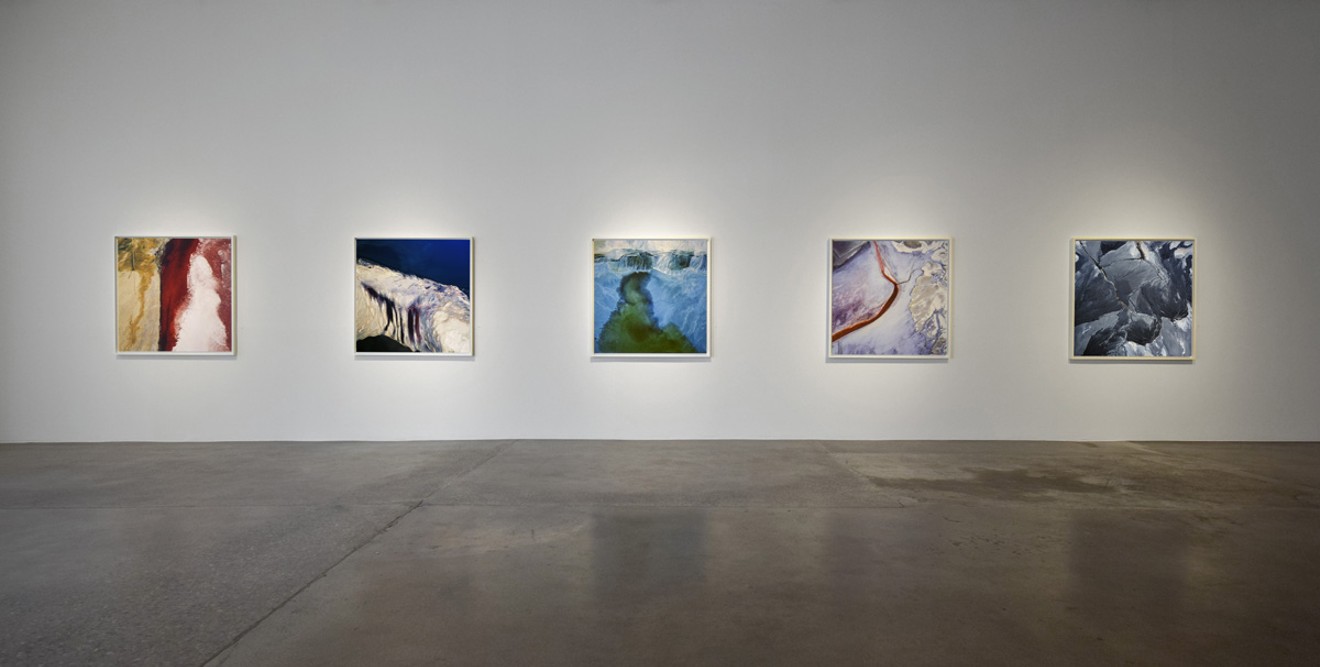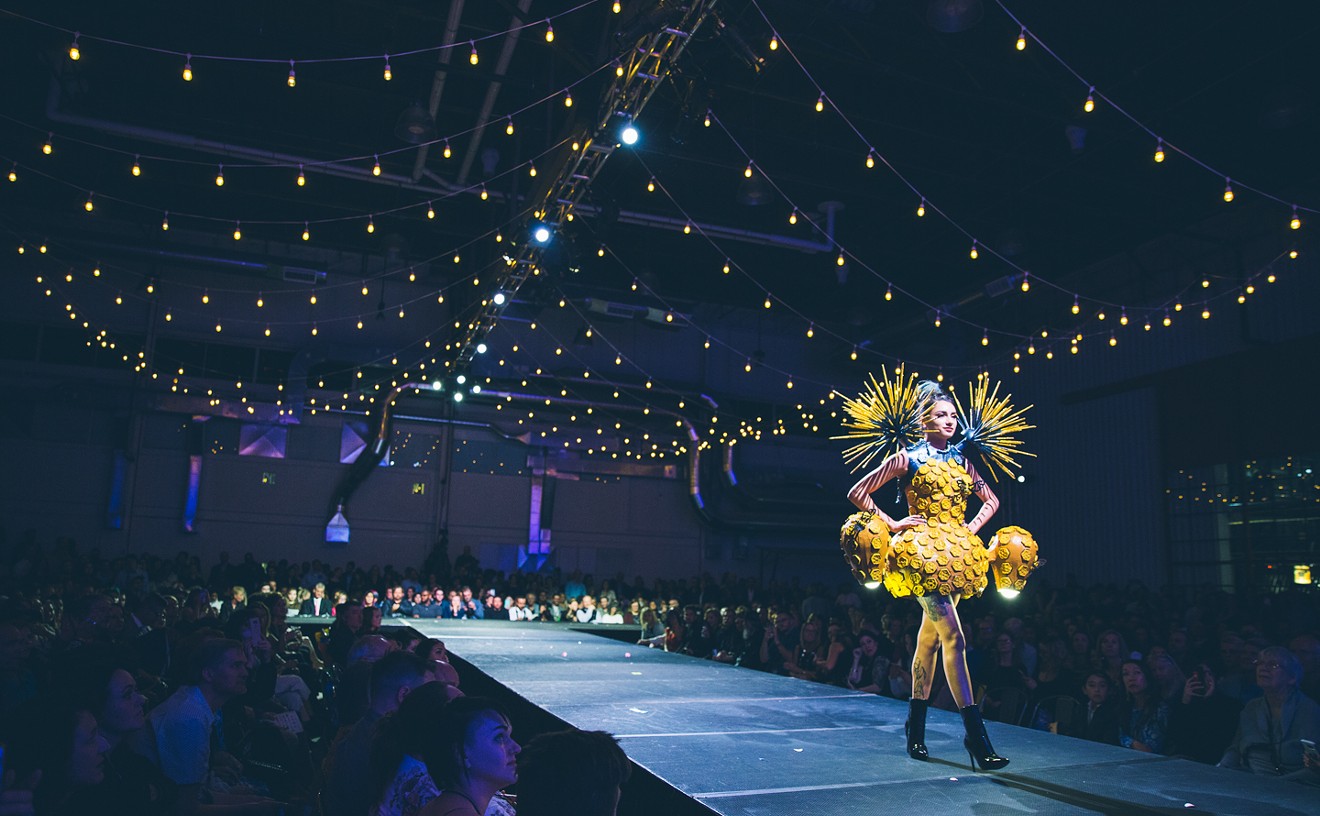In Robischon's large front spaces is David Maisel: Atlas, which at first glance looks like an abstract show, with some compositions appearing positively Still-ian. But the pieces are actually unaltered landscape photos. For more than thirty years, California-based photographer David Maisel has explored what he calls “compromised landscapes,” landscapes that have been ravaged by humanity. Broadly speaking, this brings his work into the realm of the new topographic movement, but Maisel’s photos are hardly what we think of as classic examples of that type, which typically focus on such sights as abandoned gas stations or derelict buildings rather than ecological disasters.
Maisel’s photos have been taken from an airplane and focus on enormous tracts of land; the wide scope of the view is partly why they look so much like abstractions. But there are other reasons, too, such as the often-unnatural colors he captures and the formalism of the shapes of the land masses and bodies of water that have been trapped by his camera’s viewfinder. Cropping exterior reality into an intentional composition is a key to fine-art photography, and Maisel clearly has an unerring eye for that. The results are invariably asymmetrical views that are perfectly balanced.

Three of Kevin O'Connell's "Memories of Water" photos (left) with "Untitled (BRF-6596)."
Courtesy of Robischon Gallery
It's amazing that Maisel is able to wring such beauty out of such real-life horror scenes, and the tension between the aesthetics and the realities lends his photos a chilly elegance along with their troubling narratives.
Something very different is happening in Kevin O’Connell: Petrichor, a solo in the adjacent galleries in the front of Robischon: Denver's Kevin O’Connell, one of the state's premier landscape photographers, has created lyrical depictions of the plains and the skies over them. Like Maisel, O’Connell has also done environmentally aware photos, such as his well-known images of run-down oil and gas equipment and wind turbines set amid the prairie grasses; these earlier works were also shown at Robischon, along with MCA Denver and elsewhere. This current selection does not address environmental degradation; instead, O’Connell is looking at the majesty of the plains and positing them as a scenic rival to the mountains, views of which dominate landscape photography in these parts and everywhere else.
The solo includes a trio of O’Connell’s classic shots of the plains meeting the sky in his “Memories of Water” series. In “Untitled 3029,” an endless meadow of wildflowers in spring spreads out under an about-to-rain gray sky. The shapes of the wispy and elongated clouds in “Untitled 0377” match those of the streaks of snow on the plowed field below them. In “Untitled 3377,” dead grasses cover gentle hills, while a threatening storm front pushes in above them. O’Connell uses the active though visually recessive clouds as a striking contrast to the passive yet pictorially dominant hills.
Marking a big change in approach are photos in which O’Connell has left out the horizon line. The "Big River Flat" series comprises untitled close-ups that look down at the ground toward the river bed, or above and across from the river’s elevated banks, undercutting the illusion of vastness. Just as it's somewhat contrary for O'Connell to turn his back on the mountains to celebrate the plains, it's also against the grain to eliminate the sky, ordinarily the most beautiful aspect of the depictions of the plains, as he does in "Big River Flat." But O’Connell focuses on the sky in another series that gave the show its title, “Petrichor,” with pictures of the clouds unmoored from any reference to the land. They are vaporous, all-over abstractions in shades of white, blue and gray. Interestingly, both the “Big River Flat” and “Petrichor” photos have an exaggerated horizontal format; although they do not include any depiction of the horizon, it's still evoked simply through the shapes of the pictures themselves — a neat trick.
The same spirit of contemplation is seen in James Benning: small roads, a video projection in the large back gallery. James Benning, a well-known filmmaker, recorded his trip on back roads from California to Louisiana. The roads look alike, with fields encroaching on the two-lane black top, and the hour-long film appears to comprise straight, unaltered shots. But it turns out that Benning uses digital technology to alter what he records, and has written that “the equipment can take you in either direction — to the total abstracting of the image or towards a much closer reality.” Here we're looking at what Benning views as a “collage,” in which he has invisibly overlaid or otherwise inserted different effects, such as adding rain to the scene. He does it so perfectly, however, that when he's finished, the filmed road looks completely real.
David Maisel, Kevin O’Connell and James Benning, through May 4, Robischon Gallery, 1740 Wazee Street, 303-298-7788, robischongallery.com.













